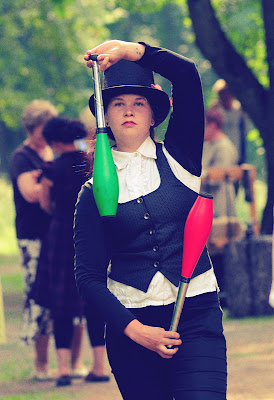You have two options:
a) Take a selfie with a mobile phone into the mirror (preferably half-naked, like a proper bimbo)
b) Read on
OK, what you have to do in order to get an engaging self-portrait is to overcome the conflict I described above. What you're dealing with is the struggle between shutter actuation and pose. Let's deal with the former first.
To fire the shutter of a camera without immediate access to it, you have the following options:
a) Self-timer
b) Cabled release
c) IR release
The option between b) and c) depends on the camera, with some models (usually entry-level) offering an infra-red remote, while upper-level bodies offering only a cabled release (you can still use an IR solution with them if you attach a battery grip that has an IR remote).
Self-timer is available in virtually all cameras.
So, what are the pluses and minuses of each solution for the purpose of self-portraits?
Self-timer:
+ ready solution, no need to buy extra equipment
+ completely "hands free", no need to press any button
- you can't control the exact timing (although the DSLR light will give you a warning about when the shutter is about to fire)
- you have to press, then run into position.
Cabled Release:
+
- clumsy solution, you need to be literally attached to the camera!
- limited range (depending on the length of the cable)
IR Release:
+ pretty small and discrete remote, easy to hide in your palm
+ you can control the timing perfectly
- you have to aim for the camera to activate; this can be problematic
- there still is something in your hand
 |
| Like with all portraits, self-portraiture is all about expression |
As you can see from this small table, I don't favor cabled release for self-portraiture. It's a good tool for, say, astrophotography or similar applications, but when you are the subject of your own photo, it's impractical. The other two options have advantages and disadvantages. What's my personal favorite? Self-timer! And you will see why right away, when we examine the second aspect of this topic, namely the posing.
If you want to take a plain ol' vanilla self-portrait, then you're lucky. You don't have to do anything other than press the self-timer (set it for 20 seconds so that you have time to get into position), then...get into position, smile, and that's it. But what if you want something a bit more engaging? Something more interesting?
This is when things get complicated, but also attractive! And this is why I favor self-timer. Because in order to be a good subject, you must not be in any way preoccupied with tripping the shutter. Ergo, forget the remote. Set the self-timer for 10 seconds (or 20, if you wanna mentally prepare), then get into position and follow the light of the camera. It blinks counting down. Once it stays on, it means the shutter will fire very soon after. Before it reaches that stage, think of something, do something, or talk about something (yes! Talk to yourself out loud!). Anything to make you look like you're doing something other than posing for a photo. You can try to recite a poem (it's OK to laugh or think it's ridiculous). You can try to remember how a football game went last night. Think how much you care about your girl/boyfriend.
If your camera is equipped with intervalometer, you can set it to take, say, 10 photos two seconds apart from each. Then, once the camera starts firing, go crazy!

No comments:
Post a Comment